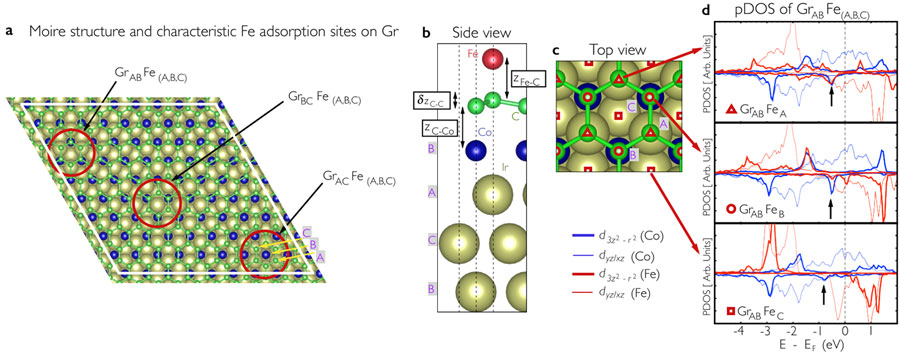Cerdanyola del Vallès, 27th September 2017. Antiferromagnetic spintronics may pave the way to innovative information storage devices with perpendicular coupling, however nowadays experimental demonstrations are still sparse. In this context, synthetic ferrimagnetic and antiferromagnetic (SFiM/SAF) structures are gaining again attention for spintronic applications and magnetic information storage. SAF structures based on metallic multilayers were initially developed in the 90s, inspired by the discovery of exchange coupling in multilayers and oscillatory magnetic interactions. A prototypical SAF structure is composed of two ferromagnetic films that are antiferromagnetically exchange-coupled through a non-magnetic spacing material due to the Ruderman–Kittel–Kasuya–Yosida (RKKY) interaction, and have been broadly used to improve the thermal and magnetic properties of spin valves. Furthermore, exchange-coupled magnetic layers with perpendicular magnetic anisotropy (PMA) are intensively studied for developing vertical magnetic tunnel junctions (MTJs), in views of their potential application in future high-density and low current-induced magnetization-switching spintronic devices.
Graphene-spaced magnetic systems with antiferromagnetic exchange-coupling offer exciting opportunities for emerging technologies. Unfortunately, the in-plane graphene-mediated exchange-coupling found so far is not appropriate for realistic exploitation, due to being weak, being of complex nature, or requiring low temperatures.
Now, a group of researchers form the BOREAS beamline of the ALBA Synchrotron in collaboration with members of the Theory and Simulation group of the Institut Català de Nanociència i Nanotecnologia (ICN2), employing element-resolved X-ray Magnetic Circular Dichroism (XMCD) and ab-initio calculations, have demonstrated that ultra-thin Fe/graphene/Co films grown on Ir(111) exhibit robust perpendicular antiferromagnetic exchange-coupling, and gather a collection of magnetic properties well-suited for applications (Fig.1). Remarkably, the observed exchange coupling is thermally stable above room temperature, strong but field controllable, and occurs in perpendicular orientation with opposite remanent layer magnetizations. Atomistic calculations confirm graphene's direct role in sustaining AF superexchange-coupling (Fig.2) between the magnetic layers, and are in good correspondence with the experimental findings.
These results provide a path for producing graphene-based perpendicular synthetic antiferromagnetic systems, which seem exciting for fundamental nanoscience but also for their potential use in spintronic devices. They demonstrate an additional class of synthetic-AF multilayered materials that, while being of fundamental interest, appear capable of providing practical magnetic devices with PMA which are potentially relevant for perpendicular magnetic recording media, perpendicular spin valves, MTJ structures, or in all-optical switching magnetic materials.

Figure 1: At the left, a schematic view of the Fe/Gr/Co/Ir(111) multilayer system. At the center, an element specific XMCD magnetization loop showing the magnetization of the Co and Fe layers with antiparallel orientation when there is no applied magnetic field. At the right: a view of the XMCD spectra collected at BOREAS showing the sign inversion of the Fe and Co magnetic signal proof of the antiferromagnetic ordering of the films.

Figure 2: Left, structural models for Fe/Gr/Co/Ir(111) heterostructures as a result of the first principles calculations. (a) Schematic top view of the Moiré superlattice defined by graphene on top of Co/Ir(111). Center: side view of the system in one configuration. Right: projected density of states (pDOS) on Co and Fe d states indicating the presence of a peak in the DOS in the stronger antiferromagnetic coupling arrangements.
The research leading to this work has been funded by Spanish MINECO/FEDER, grants no. FIS2013-45469-C4-3-R (AEI/FEDER, UE), FIS2015-64886-C5-3-P, FIS2016-78591-C3-2-R (AEI/FEDER, UE), and MAT2014-59315-R, Generalitat de Catalunya (2014SGR301), CERCA Programme/Generalitat de Catalunya, and by European Union H2020-EINFRA-2015-1 program under grant agreement No. 676598 project "MaX—materials at the exascale". ICN2 is supported by the Severo Ochoa program from Spanish MINECO (Grant No. SEV-2013-0295). P.G., H.B.V. and M.V. acknowledge additional support via ALBA IHR program. M.V. and P.G. also acknowledge Dr. A. Scholl (LBNL) for helpful discussions and M. Rosado (ICN2) for technical assistance with high-resolution SEM. R.C. acknowledges the funding from the European Union’s Horizon 2020 research and innovation program under the Marie Skłodoswa-Curie grant agreement no. 665919.




